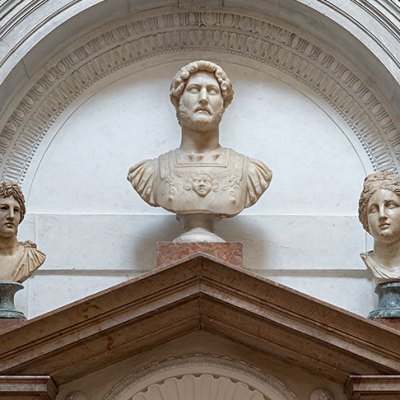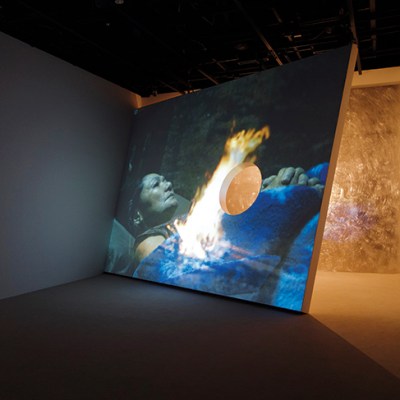In Italy’s tobacco country, where Umbria meets Tuscany, the legacy of Alberto Burri (1915–95) still burns. The career of an artist known for painting with flames was ignited in a prisoner-of-war camp in Texas, where Burri, who had been captured by the Allies in 1943, decided to abandon medicine for art. It was fuelled by Rome and fanned by regular long stays in Los Angeles, but eventually Burri came home to Città di Castello. This ancient town, named for its fortifications, sits on a slope of the Apennines in the northern Tiber valley, the Valtiberina, where the humid air has nurtured tobacco plants for centuries. Before they can be smoked, the leaves must be dried. On the edge of the historic centre, the vast sheds built for this purpose in the 1950s became Burri’s last, and largest, studio. There, he would transform his synthetic materials – drying out clay mixed with acrovinyl glue, peeling away the surface of Celotex insulation boards, melting plastic.
What began when Burri borrowed one shed in 1978 to make large-scale works ended 12 years later with the opening of this site of the Fondazione Burri. The artist installed 128 of his most monumental productions, made between 1974 and 1993, across nine enormous hangars. The complex itself is a sort of Gesamtkunstwerk, the sheds’ profile evoking Burri’s late geometric compositions. He painted the outside in the intense black that dominated his restrained palette, alongside white, red, and the sandy browns of sacks and Celotex. Inside he left in situ the system of hooks and pulleys used to rotate the tobacco, erecting walls to hang his pictures in their simple wooden frames, no text allowed. Thirty years ago, this mix of clean lines and industrial grit was not so pervasive.
Despite this contemporary aesthetic, the displays of the late series transform sheds into naves, with works sitting on the long walls like stations of the cross. These historical undercurrents come to the surface at the Fondazione Burri’s other site in the centre of Città di Castello, the 15th-century Palazzo Albizzini. Here the artist installed around 130 works made between 1948 and 1989, using his own collection and even buying back some key paintings; this site opened in 1981, the same year Burri had an exhibition at Orsanmichele in Florence. His classicising abstraction was keenly attuned to earlier architecture and his artistic forebears. The palazzo sits next door to the church of San Francesco, for which a member of the Albizzini likely commissioned the young Raphael in 1504 to paint the Marriage of the Virgin (today in the Pinacoteca di Brera, Milan). Burri, a devotee since childhood of local artists from Piero della Francesca to Luca Signorelli, deliberately placed his foundation, and positioned himself, within the art-historical lineage of the Valtiberina. His lack of formal artistic education may have liberated him from the self-consciousness of such a decision.
Returning to Città di Castello brought Burri home to personal pleasures – hunting in the Tiber valley, and his beloved Perugia football club. It also distanced him from the Roman art world. Burri did not attend the opening of his own museum and was emphatically taciturn about his work. When asked to make an artist’s statement in 1955 he said, ‘Words are no help to me when I try to speak about my painting. It is an irreducible presence that refuses to be converted into any other form of expression.’
Cellotex CW1 (c. 1981), Alberto Burri. © Fondazione Palazzo Albizzini Collezione Burri, Città di Castello

Bruno Corà, the Fondazione’s president, uses the phrase ‘irreducible presence’ as the title of an exhibition of Burri’s work at the Fondazione Cini in Venice this summer (10 May–28 July). A career survey of around 50 works, it includes some never before lent by the Fondazione Burri. It evokes the curatorial vision of the artist’s own Città di Castello installation, displaying his black works on black walls to bring out their subtle shades, and progressing chronologically through the series to demonstrate his mantra ‘My last painting is the same as the first.’ The dual nature of the Fondazione Burri also finds its equivalent: the first room covers the early series on display at Palazzo Albizzini, including the sacking, plastic, iron and wooden works so well-reflected in the 2015 exhibition shown in New York and Düsseldorf. The second room in Venice will introduce the large-scale Cellotex pieces, so central to the tobacco sheds display, to the international audience attracted by the Biennale.
The Venice exhibition is a posthumous episode in a fraught relationship with the Biennale. Early in his career, in 1952, Burri was invited to participate, only to have his two Sacks rejected. On the insistence of Lucio Fontana, he resubmitted a drawn (rather than sewn) version of the work Lo strappo (The Rip); it was accepted and later bought by Fontana. Even if Burri had success in later years, this wound was salted by the notorious award of the Golden Lion at the 1964 Biennale to Robert Rauschenberg, who had been inspired by the Sacks he had seen in the Italian’s Roman studio in 1953. Burri’s last exhibition in Venice was in 1983, characteristically choosing the remote and industrial spaces of the former Cantieri Navali (shipyards) on the island of Giudecca to install 17 paintings and one sculpture, all titled Sextant, which are now displayed in the tobacco sheds.
Taking examples of the Fondazione Burri’s collection to the international art world’s territory should draw more attention to the pilgrimage-worthy sites at Città di Castello. These continue to grow in line with the artist’s vision. At the tobacco sheds, there is a new temporary exhibition space and a permanent display dedicated to Burri’s printmaking, an area of extraordinary technical innovation. At Palazzo Albizzini, among the maquettes for set designs, is Burri’s design for the piazza outside. The Fondazione is planning to build this large architectural structure and install one of the artist’s large sculptures. The arcing metal forms of Sculpture Theatre were first made for the Venice Biennale in 1984, where the work became a place for artists to gather; the Fondazione hopes that Città di Castello will likewise become irresistible as well as irreducible.
‘Alberto Burri: La Pittura, Irriducibile Presenza’ is at Fondazione Cini, Venice, from 10 May–28 July. The exhibition has been organised with the Fondazione Burri in collaboration with Tornabuoni Art and Paola Sapone.
From the May 2019 issue of Apollo. Preview and subscribe here.


